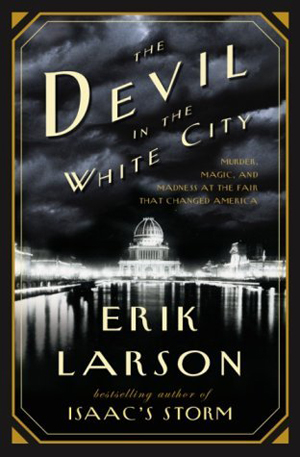 I’m late to this game, and not just because it was published in 2003. Last year I noticed a handful of people I knew reading and raving about it, so like any avid reader, I put it on my TBR list.
I’m late to this game, and not just because it was published in 2003. Last year I noticed a handful of people I knew reading and raving about it, so like any avid reader, I put it on my TBR list.
When I read nonfiction, it’s usually during Lent (which starts next week), with the occasional book here and there, often related to creativity. If you are like me and prefer works of fiction, do not let this book’s nonfiction status deter you. This story is as screwball as any fiction book I’ve read.
Erik Larson takes us to Chicago in the 1880s when the city was experiencing rapid growth. It was the Gilded Age. Industry was booming, but so was poverty and crime. It was in this setting that the city underwent an overhaul to plan and construct the greatest World’s Fair the world had seen yet. Ever-present in the minds of the architects was the primary goal: Be better than Paris.
The group of architects was a mixture of local men and a group from New York City, folks like Fredrick Olmsted, the designer of Central Park. They toiled under a short deadline, and when the park opened in May 1893, it wasn’t complete. It was finished enough to let in fair goers, but elements like the Ferris Wheel (designed by creator George Ferris himself) took extra time to complete. For all intents and purposes, the fair was a success, despite all of its troubles (and there were many). History buffs will love every chapter about the fair.
Coinciding with the fair’s construction is the rise of serial killer H.H. Holmes, a charismatic and crafty man who built a World’s Fair Hotel as a kill house. Inside its haphazard walls and deep basement were gas chambers, dissecting tables, and a makeshift crematorium where he could kill and dispose of victims secretly. It is this piece of the fair’s timeline that had me captivated until the end. The existence of H.H. Holmes proves that evil is real.
Larson separates these two timelines by chapters and toggles back and forth, mostly in sequence, so you get an idea of how they parallel. There are additional timelines, though not as prominent, such as the story behind Mayor Harrison’s assassination.
Again, this is nonfiction so all of these crazy events actually happened. Larson’s research is extensive and he provides a lengthy bibliography in the back for those who want to explore them further. Though we aren’t privy to every conversation these people had, Larson uses deductive reasoning to paint a full picture of what went down in Chicago at the turn of the century.
Truly, this book was hard to put down. I read it in 23 hours between Friday and Saturday when I had little else to do. (That’s not true. I had plenty to do. I just chose not to do it.) Leonardo DiCaprio bought the rights to the film several years ago and word has it that Martin Scorsese will direct it. Opening night, people. I’ll be there.

One of my favorite books. I have my students read it every year.
I didn’t think about it being a book for history class, but you are correct! It would be a good one.